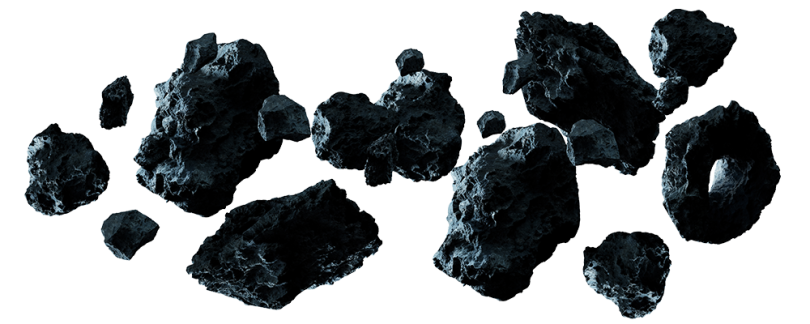Carrots. Asteroids. Humanity.

It begins with a question or an idea that grips your imagination.
How will we reach that asteroid?
How will we feed the hungry in Kentucky while reducing food waste?
How will we address inequities through public health initiatives in Chicago?
The challenge might seem insurmountable in scope—an entrenched social injustice, a shortage of global resources, a citizenry hungry for food. Sometimes the question is posed by someone else, and you know in your heart the solution will lay dormant without you.
So the question provokes, nags, inspires, becomes an ineluctable presence in your life. It fixes a vision in your mind of “What if?” and won’t let go until it becomes “How?” and “That’s how.”
Pioneers ask big, purposeful questions. But, more to the point, they’re not afraid of jumping in to answer them. They’re able and willing to take risks and give the marrow of themselves as they serve as the catalyst.
Where does this come from: this intertwining of deft ability to think strategically, creatively and connectedly; the confidence to take action; a willingness to change with a changing world; and the empathy that compels Pioneers to think beyond themselves?
Professor Tim Soulis points to the “ability to think metaphorically,” to see new associations, “to link together ideas that were formerly disconnected and unrelated.” How else can new solutions be found?
Part of the DNA of our liberal arts tradition at Transy is a curriculum that, as Soulis describes, “requires holistic thinking.” It frees Pioneers from old patterns of thought by exploring other disciplines and perspectives and developing an understanding and empathy for others. “Getting outside our bailiwicks,” he explains, “really encourages people to see beyond preconceived notions.”
Meeting the enormous challenges before us demands a mutability, a devotion and an often brutal work ethic. No one said it would be easy. This is no movie-of-the-week scenario that arrives at redemption after a two-hour struggle. This is slog. This is fantasy. This is relentless purpose. This is Pioneering to the core.
How we transmute the insurmountable
“Are people hungry in Lexington?” someone once asked Lexington native Erica Horn ’83.
The question must have seemed rhetorical to the co-founder and past president of GleanKY, a nonprofit organization that harvests excess fresh produce to feed the hungry—over one million pounds since its founding in 2010. (That’s over one million pounds that did not end up in a landfill.)
In fact, people are hungry throughout the Commonwealth: One in six of all Kentuckians and one in five of children are “food insecure.” According to Feeding America, that adds up to 699,590 people, of which 202,050 are children.
How is such a problem resolved? How can hundreds of thousands of mouths be fed with anything less than a miracle involving fishes and loaves? How can the 40 percent of food that is wasted in America be redeemed?
Or, in Pioneer speak, “What are you going to do about it?”
There’s a big difference between recognizing two monstrous problems— hunger and food waste—and helping to resolve them on a grand scale in your own community.
Throughout Horn’s career and decades of intense community service, she has learned to respond to giant questions much as David felled Goliath—with faith and the right tool. She breaks the challenge down into components, researches elements that worked in other communities, identifies the basic processes and unites the partners needed to arrive at what, in hindsight, appears to be forehead-smackingly doable. The efficiency and purity of the construction begs the question: How is it that we, as a civilization, didn’t do this sooner?
I knew nothing about vegetables. I knew nothing about growing anything, but I knew that I could put a group of people together, divide a piece of property into squares and sign people up.
Erica Horn ’83
As a lawyer and CPA, Horn says, “It’s natural for me to create structure. No one would like that more than me.” But finding solutions demands more than structure. Horn brings devotion, creativity and generosity, and puts the ego aside.
On top of a demanding job, currently as associate director of tax services at Dean Dorton, Horn has led statewide boards and started a learning center and a community garden at her church, Beaumont Presbyterian. The garden became the starting point for Faith Feeds, the origin of GleanKY.
“I knew nothing about vegetables,” she remembers. “I knew nothing about growing anything, but I knew that I could put a group of people together, divide a piece of property into squares and sign people up. It’s really a matter then of deploying your people, your assets,” she says of the flourishing community garden that first drew the attention of a local gardener and gleaner, John Walker.
Inspired by the bounty of his own garden, which could feed his family, friends and co-workers and still have plenty for others, Walker was also living out the Old Testament tradition that calls on farmers to leave the edges and viable remnants of their harvest for the good of the poor, strangers and widows. John Walker approached Erica Horn with the idea of engaging the church and other community gardeners to become active gleaners and to provide excess produce to people in need.
They began by approaching a farmers market and organizing volunteers to deliver unsold food to shelters and emergency food services in Lexington. By the end of their first year, as their annual report details, 40 volunteers delivered 37,561 pounds to 14 agencies and ministries.
Just as GleanKY became the link between those producing the food and those preparing food for the hungry, Horn served as the linchpin for John Walker’s idea and bringing that idea to fruition.
“One of the gifts that God has given me,” she acknowledges, “is I can take a really good idea like John’s and, with help, make it happen.” She recognized its value and the consequences of not getting involved. “I knew if someone didn’t take the lead, it wouldn’t happen.”
From the very start, GleanKY was structured to tap into people’s strengths and to be a collaboration of multiple faith groups. And, as the organization has grown to reach beyond Lexington, its model consciously adapts to accommodate the varying environments of Kentucky counties; not every county has a farmers market or a Costco.
Horn is determined to make GleanKY a sustainable enterprise. Her tenacity, work ethic and talent for strategy, action and long-range thinking have been acknowledged in an award from the Kentucky Nonprofit Network. And although the seeds of her motivation to serve may have been planted in her childhood during Sunday school, she notes that “Transy was the place to help grow my abilities to execute, lead and learn the importance of knowing other people.”
As she assesses the state of the world, she concludes, “We’re in short supply of leadership, but at Transy you see a lot of movers and shakers. These students care and want to make a difference.” She adds, “Transy gives you a place to start and the confidence that you can.”
Why we ask “What if?”
As a student at Transy, Lydia Lissanu ’15 was deeply engaged in issues of identity, race and equity. She dreamed of solutions to the intractable “what ifs” on campus and in the immediate neighborhood. Unresolved questions of big-picture possibilities motivated her work as a student researcher in Kenya and in community service in Lexington, where she worked on civil rights issues—hate crimes, mental health advocacy and the restoration of felon voting rights.

A scholar at Yale’s Summer Institute in Bioethics, she was invited back to be a program assistant the summer after graduation, where she gave a lecture that raised questions about the women we don’t see in social justice movements and the transgender women “erased from public discourse.” She has an ability to see what’s missing.
All of this, and her love of sociology, biology and political science, drew her to a career in public health. She’s devoted to the profession that, she says, “looks for novel ways to treat illness from a biological and sociological framework” and “puts science behind our ideas.”
Lissanu works as a health educator with people at both ends of the age spectrum: K-12 students at a public charter school and senior citizens at the University of Chicago Medical Center. She sees her job not simply as a means of conveying healthy practices, but of listening, connecting, creating and broadening understanding. She uses her interdisciplinary liberal arts training on a daily basis.
Working in the hospital nephrology ward on research funded by the National Institute of Health, her goal is to help doctors better understand and treat patients from the South Side who are African American. Increasingly, patients in their 30s and 40s have been joining the ranks of elderly as sufferers of kidney disease.
“The reasons aren’t a secret,” she notes, “but we’re trying to prove why those reasons exist.” Exploring the patients’ paths to the ward, Lissanu finds a lifetime of inequity, racism and poverty, and diets derived from food deserts that lack fresh produce, offering only fast foods laden with salt and sugar.
I try to see where there are similarities in our experience, and I also try to respect the differences between us as well
Lydia Lissanu ’15
She sees associations and opportunities where others might not. She asks patients with kidney disease, who are often at the end of their lives, “What would you want to tell your younger self before you got diagnosed with kidney disease?” She then shares their messages with her students to help them make the connection between diet and long-term health. In doing so, she acknowledges that learning and motivation don’t magically provide access to healthy food. Her students still live in the same food desert.
Perhaps even more important than teaching health, Lissanu shares fundamentals from her own education at Transy. “I try to teach them to think structurally,” she says. She encourages her students—“whose lives are harder through no fault of their own”—to ask questions, to identify the challenges they face, to link them back to the source of the problem and to understand the kinds of actions they can take to make their voices heard.
At a summit on violence, Lissanu watched the hands of her students repeatedly extend upward in response to a series of questions: “Have you been jumped by three or more people? Do you know someone who has been shot at your age? Do you know someone who has died from being shot?”
As students of a public charter school that is just a few blocks from a private charter school, Lissanu and her students can readily contrast, point by point, resource by missing resource, the day-to-day experience of those who have financial health and those who do not. But Lissanu isn’t cowed by these monumental challenges or from asking how public policy can help dismantle systems of inequality.
What if racism and systems of inequity didn’t hold our young people back? What if public health policy could be that change?
Her thoughts and questions emerge large and beyond herself, yet are rooted in her experience as the daughter of parents who emigrated from Ethiopia and made a home and productive life in Somerset, Ky. “Financially, my parents were able to climb,” she explains. “They came here. They got an education.” She adds, “I want to make sure I give that to my kids that I’m working with.”
Many of the words, ideas and theories that she uses were developed at Transy, she explains, from an awareness of LGBT issues to examples of what economic justice looks like. “For me, a really important part of going to Transy was understanding the diversity of experience in being black.”
Not taking anyone’s experience for granted is vital to her ability to interrelate.
“I didn’t grow up in Chicago; I grew up in rural Kentucky. My parents aren’t the descendants of slaves. I try to see where there are similarities in our experience, and I also try to respect the differences between us as well.” She thinks a lot about empathy and how to build it.
Listening has become as important as asking the questions, not only because she wants to give voice to people who are on the margins of society, but also to learn. Clinicians, she notes, don’t have all the answers. “We know the disparities exist, but we don’t all agree on how to make it better. If we knew it all, then we would have already fixed the situation,” she laughs, undaunted.
Questions now come at Lissanu from every angle: patients, doctors, students, parents, administrators, the public and herself. “There are times,” she realizes, “that I feel I don’t know enough and I still can’t give back enough. I want to do more.” So her next steps are to earn an M.D. and then a master’s degree in public health in order to effectively treat patients and change public policy. She’s committed to a life in public health. “I really love this profession,” she adds.
Lissanu may worry about her students, but she’s also excited for them. She knows their potential and that their ability to impact the future is within their reach, whether it’s on the school level or by voting in the next election cycle. “I have a lot of hope for this generation,” she says. “They’re way smarter than I could ever be. They just need a proper education to gain the tools that will take them further and amplify their voice.”
How we integrate the parts
Asteroids and Eastern Kentucky. Hard science and science fiction. Outer space and Earth’s resources. These dimensions—seemingly incongruent on the surface—are integrated in the working imagination of Les Johnson ’84. His liberal arts way of thinking is the bridge. His intellect, wide-eyed wonder and evangelical enthusiasm for deep space are the clinchers.

From the time he was a boy in Ashland, Ky., watching Neil Armstrong walk on the moon, he has been in thrall to outer space. Today, Johnson is a technology manager for NASA’s Marshall Space Flight Center and the Solar Sail Principal Investigator for the Near-Earth Asteroid Scout Mission. After hours, he’s a writer and frequent collaborator on popular-science and science-fiction books. Fascinatingly, the worlds are totally intertwined in Johnson, each feeding the other.
Looking into the night sky, he says, beckons big questions about our place and meaning. “To people who have not experienced the epiphany of a cloudless, no moon, starry night sky,” he muses, “I don’t know how to describe it. It’s a spiritual, emotional experience for me.”
For him, there is something similar to be found in well-written science fiction that draws the reader into wondering: “Are we alone in the universe?
What would it be like to visit these other places?” He says he gets the same “sense of awe and wonder of nature and the universe” from science fiction and physics. “And now, I get it in my day job. I’m very lucky.”
At NASA, Johnson is considered by some to be “on the edge” in terms of technologies because of his imagination and enthusiastic propensity to convince. “I want to push the envelope,” he says. And at sci-fi conventions—where he was welcomed as a teen fan and, later, as a post-Transy critical thinker with a keen ability to explain physics—he’s thought to be a tad corporate; he represents NASA’s scientific protocol of peer-reviewed science, rigor and due diligence. But he is highly successful and respected by both camps, with three prestigious Exceptional Achievement Medals from NASA, four space technology patents and multiple books of popular science and science fiction in publication.
Imagine gently propelling a craft through outer space using no rocket thrust, just a solar sail consisting of a large, thin sheet of film that reflects sunlight. After rocketing through the earth’s atmosphere, the mission relies on reflecting photons—light particles—to reach an asteroid and collect data.
Now picture convincing your superiors at NASA that this is a viable idea. Professionally, Johnson has been focused on solar sails for NASA since 1999. “But in my imagination,” he says, “it’s much earlier than that.” It’s the idea he convinced NASA to use, so the responsibility is his to make it work.
The solar sail that he first read about in 1970s science fiction is now the propulsion system for the Near-Earth Asteroid Scout mission that will be launched next year. Yes, it’s rocket science, but for Johnson, it’s also the interplay between hard science and the imagination that fuels his love of science fiction.
“This is the first flight of a solar sail that I have led and the first one that NASA or anyone in the United States has flown beyond Earth and into deep space,” he explains with equal measures of glee and sober realism.
“Nature is trying to stop you at every turn. So, when you propose to do something new, it’s very difficult to get that through the system because of the inherent risks—and expense—of doing something no one’s done before.” But he harped on the benefits of the new capability and successfully made his case.
According to the NASA website, 1,409 near-Earth asteroids (having orbits that pass nearby the Earth) pose a potential hazard to our world. We need to know more about them. But for Johnson, asteroids also present an opportunity.
As a native of Eastern Kentucky, he advocates the idea of mining asteroids to protect our planet. It’s why he co-wrote “Harvesting Space for a Greener Earth” and, more recently, a sci-fi novel. “Mission to Methone,” set in 2068, begins with an asteroid mining company looking at asteroids to mine; their survey vehicles are small aircraft propelled by solar sails. He thinks it will be common practice in 100 years.
“I see some real problems facing us as a world, with energy and the environment. I think things we’re doing in space can help solve some of those problems.”—Les Johnson ’84Johnson writes “hard science” science fiction, meaning that the physics in his futuristic setting is physically possible. “My day job and education influence my writing in that I try to make the settings believable in science fiction. It’s hard to say where the distinction is because in my day job I get to dream up some pretty cool stuff. If it’s too cool for work, I take it to fiction,” he laughs.
The inspiration for “Mission to Methone” came during a series of weekly “risk management” meetings for the Near-Earth Asteroid Scout Mission. All of the experts gathered to brainstorm everything that could conceivably go wrong: “The rocket can fail. The communications antenna can fail. The power supply goes out. You get a cosmic ray that causes your computer to malfunction. There are a gazillion things that can go wrong,” he explains.
One day, several weeks into the relentless meetings, the person responsible for creating the flight plan from Earth to the asteroid introduced a less-than-one-percent chance that the asteroid could, in fact, be an old Saturn 5 rocket that had been captured in orbit around the sun.
“We all turned around and looked at him and chuckled,” Johnson recalls. But the idea, however fleeting, was enough to grab Johnson’s imagination. For a moment he zoned out and thought, “Wow, what if it is an old space ship and it’s not from Earth? What if it’s been there for 50,000 years?” He plotted the novel that night. “Mission to Methone” was published last February.
“So that’s how they interact,” he says. “People have their hobbies. I’m in my technical world at work. Literature and fiction are in a different part of the brain. For me, it’s cathartic. It’s recreational to write.” In the same month as “Mission to Methone,” he also published a nonfiction book, “Graphene: The Superstrong, Superthin, and Superversatile Material that Will Revolutionize the World.”
The many challenging dimensions of Johnson’s productivity relate directly to his liberal arts grounding: the unleashed imagination, the ability to integrate the many parts, the skill set and experiences that prepared him to communicate with a wide range of people and to convincingly make the case that is requisite to moving a project forward. He trumpets these connections, along with the ability to organize and manage projects of enormous scale.
In fact, he attributes so much to his Transy experience that he insists to every intern he works with at NASA who has chosen a strictly engineering education, that they spend summers taking humanities courses, creative writing and public speaking. “I guarantee you it will help you be better in your field,” he tells them. (His daughter recently graduated from Transy.)
Ultimately, he describes what he does as a moral obligation. “I see some real problems facing us as a world, with energy and the environment. I think things we’re doing in space can help solve some of those problems. And if we don’t start working on them now, then the solution gets postponed. We’d better start now.”
We think, therefore we can
Whether through produce, policy or spacecraft propulsion, Pioneers use their liberal arts way of thinking to move beyond the status quo, the head-scratching and inertia that come of not knowing how or where to begin. How else can the world’s exceptional challenges be met?
Solutions require an ability to look beyond oneself to see the vast scope of a problem: the creativity to see unexpected connections; the intellect to structure the action; an empathy that drives motivation; a freedom that comes from being open; a collaborative spirit that inspires solidarity of pursuit among a broad network of participants; and that grip, that Pioneer tenaciousness—even righteousness at times—to keep at it, relentlessly and unfailingly, knowing that the struggle, like the challenge before us, is an opportunity. Pioneers understand that the value of our existence extends beyond our personal goals to something much larger than ourselves.
If solutions were easy, we wouldn’t need Pioneers.

